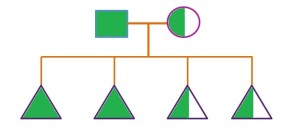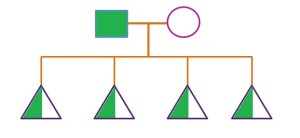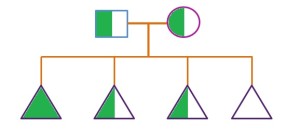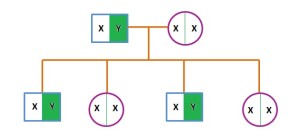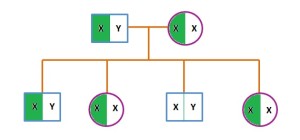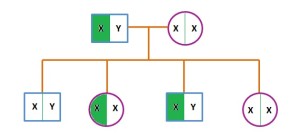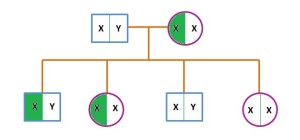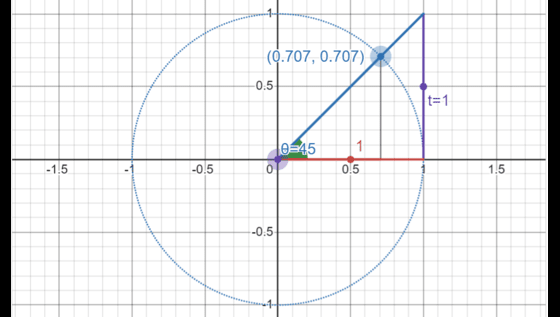Overview:
Pedigrees are visual representations of a family’s genetic history. Each pedigree focuses on one specific gene that is studied by geneticists. There are several benefits of studying a family’s genetic history. By reviewing past generations, scientists can deduce the mode of inheritance for a specific gene. A person can study their family’s pedigree to determine if they have the trait or are a carrier of the gene for that trait. Parents can also determine if their children will inherit the trait or become carriers. Pedigrees play a significant role in the studies of genetic diseases and illnesses.
Autosomal Dominant Gene
Autosomal dominant genes are found on autosomal chromosomes, and therefore are unaffected by gender. Affected individuals are common, and have at least one parent with the trait. The trait often appears in each generation. Parents who are unaffected will only produce children without the phenotype.
Autosomal Recessive Gene
Autosomal recessive genes are unaffected by gender, since they are located on autosomal chromosomes. Parents do not need the phenotype to produce a child with the trait, but parents who both have the trait will only have affected children. The phenotype can sometimes skip generations and appear in younger family members.
The diagrams below show how autosomal domninant and autosomal recessive traits are passed on through generations.
Figure 1: Offspring of homozygous dominant and heterzygous dominant parent.
In figure 1, we can see that a parent that is homozygous dominant and a parent that is heterzygous dominant (only one allele carries the dominant trait), will produce offspring that will all phenotypically show the dominant trait. Each child has a 50% chance of presenting the dominant trait on both alleles and 50% chance of carrying the dominant trait on one allele.
Figure 2: Offspring of homozygous dominant and homozygous recessive parents.
In figure 2, we can see that a parent that is homozygous dominant and a parent that is homozygous recessive (does not carry the trait at all), will produce offspring that only carry the trait on one allele. Phenotypically, this means that all offspring will show the dominant trait.
Figure 3: Offspring of heterzygous dominant parents
In figure 3, we can see that if both parents are heterzygous dominant (only carry the dominant trait on one allele), then their offspring may have 3 possible genotypes. Each offpspring will have a 25% chance of being homozygous dominant for the trait (carries dominant trait on both alleles), a 50% chance of being heterzygous dominant for the trait (carries dominant trait on one allele) and a 25% chance of being homozygous recessive for the trait (does not carry dominant trait at all). Phenotypically, there is a 75% chance that each offspring will show the dominant trait and a 25% chance of not showing the trait.
Y-Linked Gene
Y-linked genes are found only on the male Y chromosome. As a result, only males in a given family are affected. A father will pass this trait onto all of his sons, as each son inherits an X chromosome from his mother and his father’s Y chromosomes. Daughters will never inherit the trait since the Y chromosome is not inherited.
Figure 4: Offspring of Y – linked trait
X-Linked Dominant Gene
Dominant genes found on the X chromosome affect both males and females of a pedigree. The gene can be inherited from either the mother or father, and passed onto the children. Both genders will always express the phenotype if the gene is inherited. A father with the trait will always pass it onto his daughters
X-Linked Recessive Gene
Genes that are both recessive and found on the X chromosome can also affect both genders. However, the majority of affected family members are male; the phenotype is not always expressed if the gene is inherited. A female must inherit two X chromosomes with the gene in order to express the trait, while a male must inherit only one affected X chromosome. A mother who expresses the phenotype will pass it onto all her sons, and parents who both have the trait will have only affected children.
The diagrams below show how X-linked dominant and recessive traits are passed on through generations.
Figure 5: Offspring where both parents are affected.
Figure 6: Offspring where only the father is affected.
Figure 7: Offspring where only the mother is affected.
The patterns and characteristics within pedigrees allow geneticists to determine individual genotypes. Modes of inheritance can be determined through careful analysis of a family’s genetic history and pedigree. With the results of these studies, scientists can determine causes of hereditary diseases and illnesses. Parents have the ability to determine the probability of their children inheriting genes associated with health risks. As medical technologies advance, traditional pedigrees continue to shed light onto the study of genetics.
Interested in biology tutoring services? Learn more about how we are assisting thousands of students each academic year.
SchoolTutoring Academy is the premier educational services company for K-12 and college students. We offer tutoring programs for students in K-12, AP classes, and college. To learn more about how we help parents and students in Buffalo, NY: visit Tutoring in Buffalo, NY.


